Vietnam Teaching Jobs (VTJ)‘s latest blog post highlights 15+ famous traditional craft villages that you should visit on your trip to Vietnam. From pottery, silk, and lacquerware, to ship-crafting and more, these villages showcase the unique and diverse cultural values of Vietnamese handicrafts. Visiting these villages not only provides you with a chance to observe the traditional techniques of making products but also to create your own souvenirs to bring back home. With this comprehensive list, you can choose your favorite craft village to explore and have a more authentic and memorable experience in Vietnam.
8 Must-Visit Traditional Craft Villages in Northern Vietnam
1. Bat Trang Ceramic Village (Hanoi)
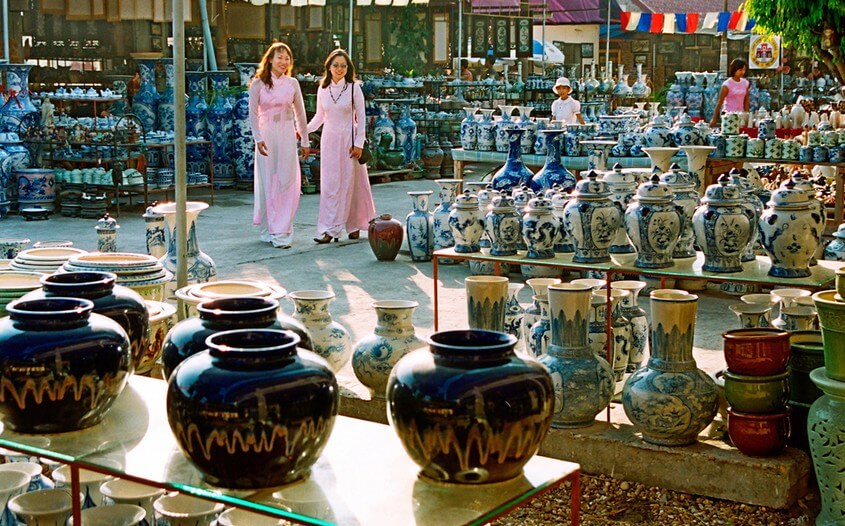
Bat Trang Ceramic Village is not only a testament to Vietnam’s rich history and culture but also to the country’s thriving handicraft industry. For centuries, the village has produced exquisite pottery and ceramics, earning a reputation for quality that has spread far beyond Vietnam’s borders.
What makes Bat Trang so special is its location. Situated along the banks of the Red River, the village’s clay-rich soil has provided the raw materials for generations of artisans to create some of the most beautiful and durable pottery and ceramics in the world.
Visitors to Bat Trang are treated to a fascinating glimpse into the world of pottery making. As they wander the narrow streets and alleyways, they can watch skilled artisans at work, molding and shaping the clay into various forms.
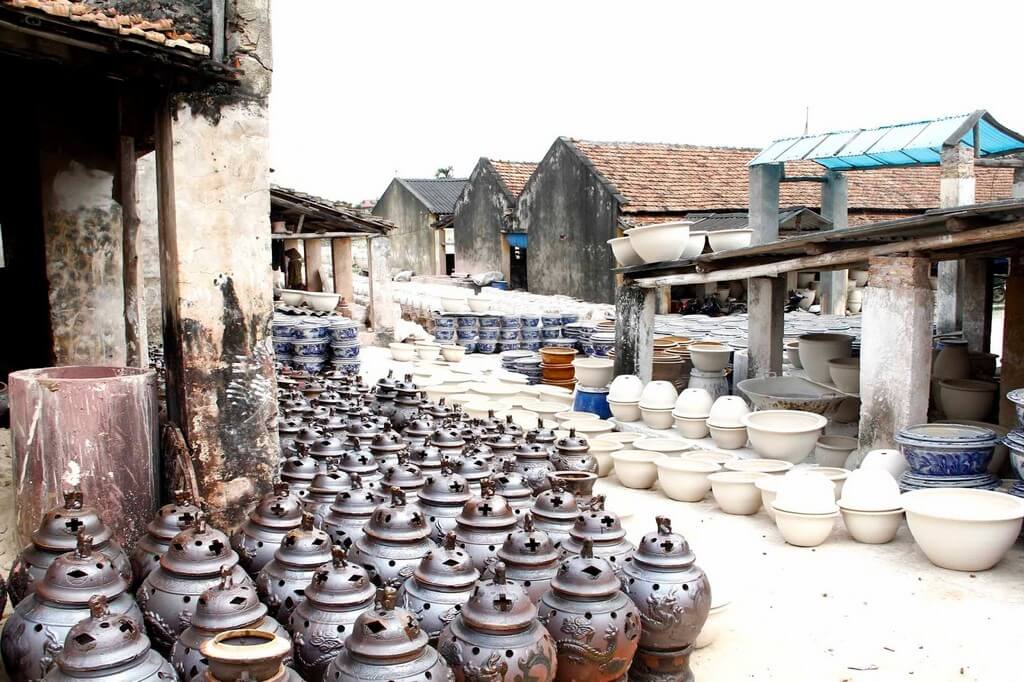
But Bat Trang is not just a place for sightseeing. It is also a thriving commercial center, with many shops and showrooms selling a wide variety of pottery and ceramic products. From plates and bowls to vases and figurines, the range of products on offer is truly impressive. Many of these items are suitable for everyday use, while others are more ornamental and decorative.
To cater to the growing number of tourists, Bat Trang has developed a range of activities and experiences. Visitors can take part in pottery-making classes, guided village tours, and even buffalo rides. There are also many cafes and restaurants in the village, serving up delicious local cuisine.
Bat Trang is an easy day trip from Hanoi, with regular buses and taxis available. For anyone interested in Vietnamese culture and handicrafts, it is a must-see destination.
Location: Bat Trang commune, Gia Lam district, Hanoi
Explore More About Vietnam: Best time to visit Vietnam: all things that you should know
2. Van Phuc Silk Village (Hanoi)
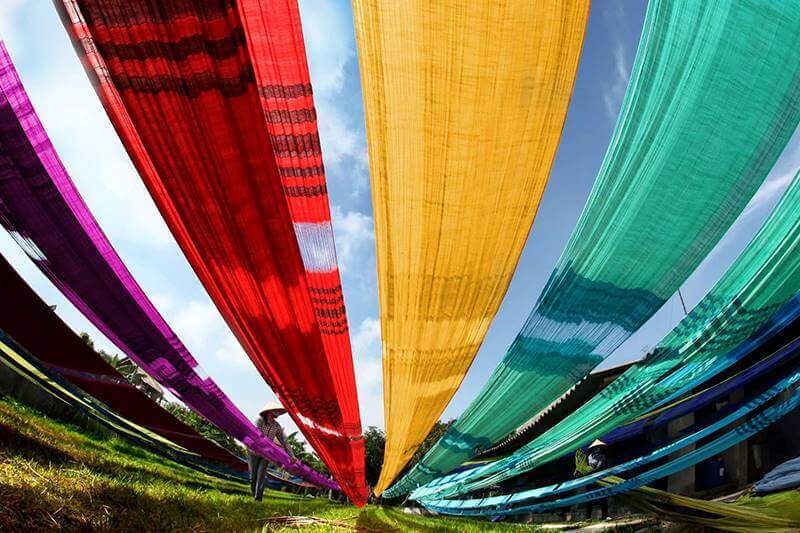
Van Phuc Silk Village is an ancient village located in Ha Dong District, about 10 kilometers southwest of Hanoi. This village has a long history of producing high-quality silk products that date back to the Ly dynasty in the 11th century. However, it was not until the 19th century that Van Phuc became famous for its silk weaving and became one of the most visited traditional craft villages in Hanoi.
Van Phuc silk has been recognized for its smooth, light, and cool texture, making it a favorite among both locals and tourists. In the Nguyen dynasty, Van Phuc silk was used to make dresses for the royal members of the Hue Imperial Citadel. Later on, Van Phuc silk was brought to Europe, and it gained popularity after being showcased at an international silk exhibition in France in the 1930s.
Visiting Van Phuc Silk Village is an opportunity to step back in time and experience the traditional way of life in a northern Vietnamese village. You can watch local artisans work their looms to create a variety of silk products, including scarves, dresses, ties, and much more. As you explore the village, you will see massive banyan trees, ancient wells, and communal houses that have stood for centuries.
There are many colorful silk shops in the village where you can choose from a wide selection of apparel and souvenirs to bring home with you. The prices are reasonable, and you can be sure that you are getting the best quality silk products in Vietnam. Additionally, the village has several museums and exhibitions that showcase the history of Van Phuc silk and the techniques used in weaving this exceptional fabric.
Location: Van Phuc ward, Ha Dong district, Hanoi
3. Quat Dong Embroidery Village (Hanoi)
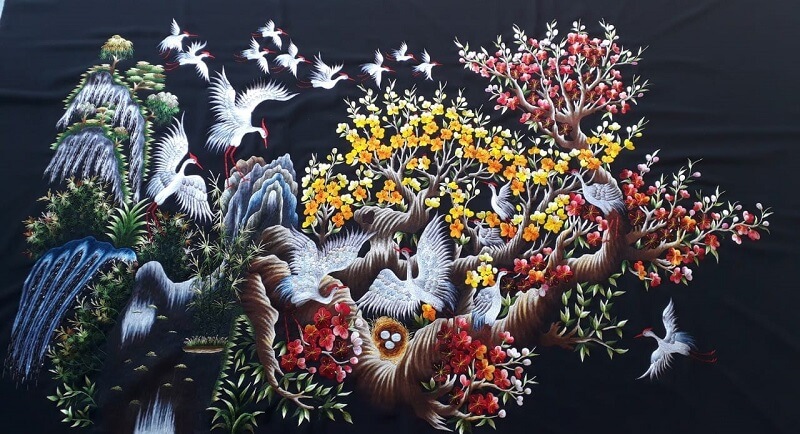
Quat Dong Embroidery Village is a unique destination in Hanoi for visitors who want to explore the traditional craft of embroidery. The village has been well-known throughout Vietnam for its intricate needlework technique for generations. The villagers here have passed down the skill of embroidery from their ancestors, and many of them consider it a long-standing tradition.
The magic of Quat Dong embroidery lies in the colorful threads and the small needle, which are used to create beautiful designs on the cloth. Visiting Quat Dong Embroidery Village allows you to not only witness the creation of beautiful art pieces but also to learn more about the cultural and historical values that have been preserved and passed down through generations.
Location: Thuong Tin district, Hanoi
4. Chuong Conical Hat Making Village (Hanoi)
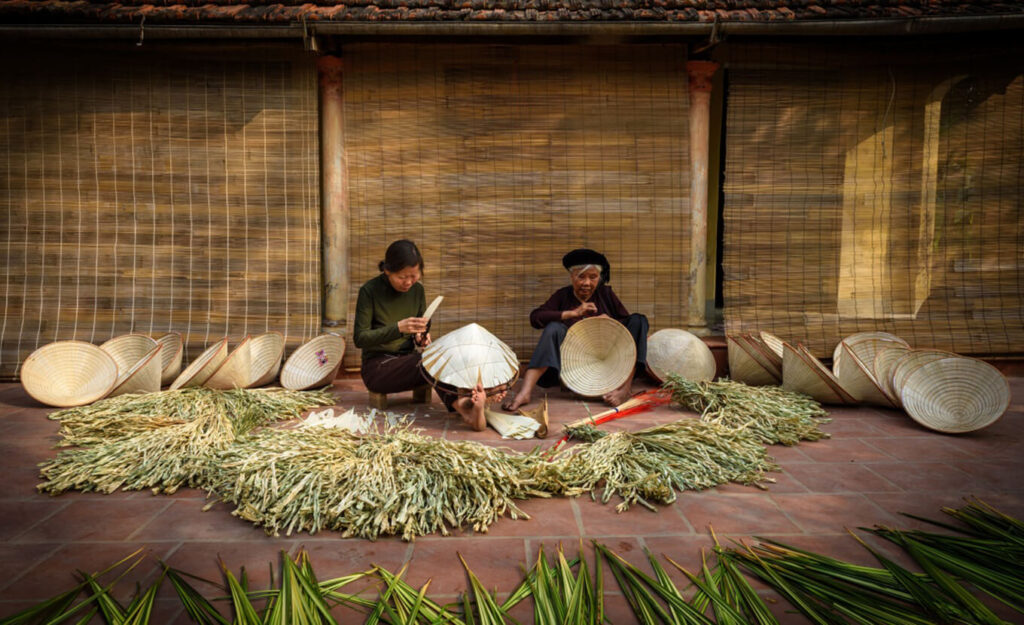
Chuong conical hat-making village is located in Thanh Oai district, on the west side of Hanoi. The village has a long history of making traditional conical hats, which are an important part of Vietnamese culture. For many generations, the villagers have quietly worked to keep this custom alive and uphold their reputation for producing high-quality hats.
The making of conical hats requires a great deal of skill and patience. The process begins with selecting the right palm leaves, which come from Quang Binh province. The leaves must be dried and flattened before they can be used. Next, the leaves are cut into round shapes and stitched together with silk thread from Trieu Khuc village. The stitching must be done carefully to ensure that the hat is strong and durable.
Finally, the hat is completed by adding a bamboo frame, which comes from Hoa Binh province. The frame is carefully inserted into the hat, and the edges are folded over to give it a finished look. The resulting product is not only beautiful but also practical, as it can be used to shelter from the rain and sun.
Visitors to Chuong village can watch the artisans at work and even try making their own conical hats. The village is a great place to learn about Vietnamese culture and traditions, and the hats make great souvenirs to take home.
Location: Phuong Trung commune, Thanh Oai district, Hanoi
5. Kim Son Sedge Mats Village (Ninh Binh)
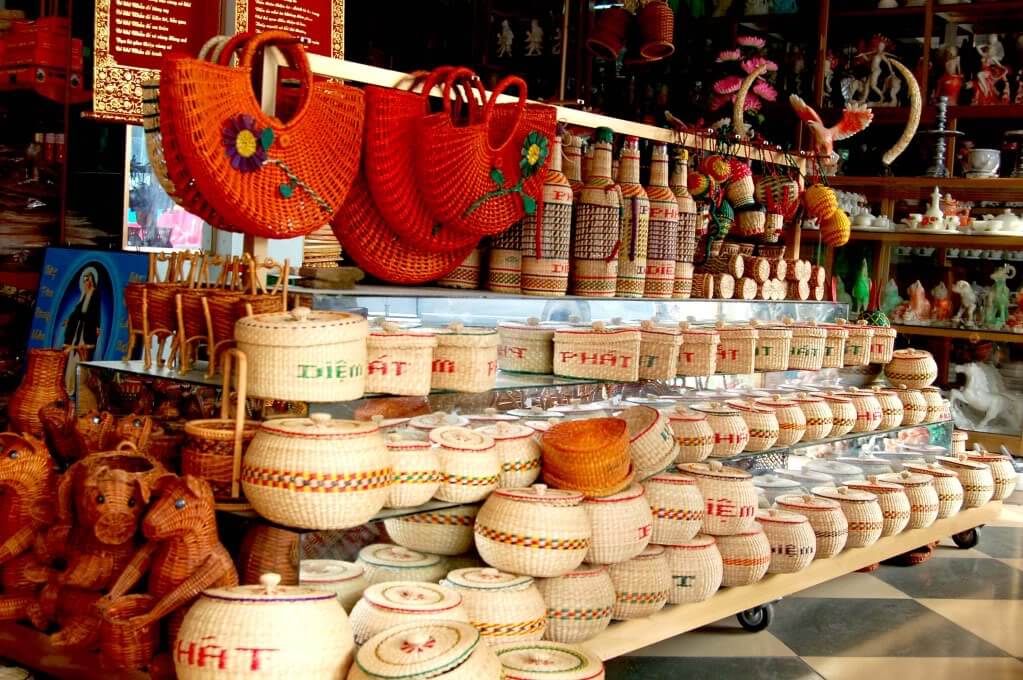
Kim Son Sedge Mats Village is located 30 kilometers away from Ninh Binh city in Vietnam. This village is widely known for producing high-quality sedge handicraft products.
The villagers carefully harvest the sedge plants before they are dried and brought to the market. Once at the market, the sedge plants are woven into beautiful and durable mats and other products that you can admire and purchase when you visit the village.
The mats made by the villagers of Kim Son are not only beautiful but also very durable. It is hard to find similar quality products in other places. In addition to mats, the range of products made from sedge has expanded and diversified over the years. Visitors can now find various products like lanterns, carpets, boxes, cups, handbags, and more.
If you’re planning to visit Ninh Binh, Kim Son Sedge Mats Village is a must-visit destination. You can witness the skilled artisans at work, learn about their techniques, and purchase some unique and beautiful souvenirs to bring back home.
Location: Kim Son district, Ninh Binh province
6. Dong Ho Painting Village (Bac Ninh)
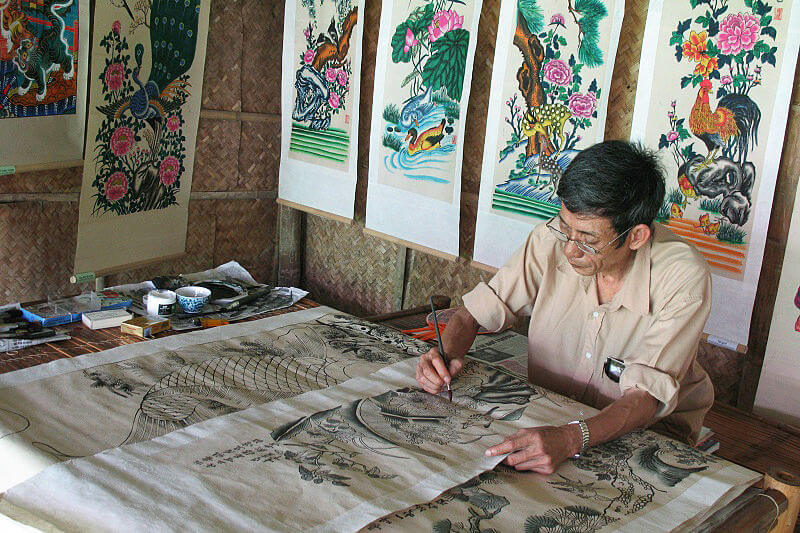
Dong Ho Painting Village, located in Bac Ninh province, is a small village that is 35km away from Hanoi. The village is famous for its traditional Dong Ho paintings that are used as home decorations and are especially favored during Lunar New Year celebrations. The paintings typically depict scenes of rustic daily life, historical figures, and wishes for happiness, fertility, and prosperity. The paintings’ special feature is the ink, which is made from natural ingredients such as the ash of burned bamboo leaves, ground oyster shells, and flowers, making the colors durable.
Dong Ho Painting has become a part of Vietnamese culture and has inspired modern Vietnamese artists. The best time to visit the village is in lunar December, just before the Lunar New Year, to experience the vibrant atmosphere and watch skillful artists passionately create their paintings.
The village is quite small, with no more than 200 households, and villagers mainly earn their income by making paintings. Looking at their products, visitors can get a deeper insight into the beauty of Vietnam, as well as traditional customs and Vietnamese festivals. These paintings used to be precious decorations during the Tet holiday, and they are unique as they are printed on poonah or Do paper, which is made from the powders of Do trees. The paintings use five main colors, including green, red, yellow, black, and indigo, which are mostly created from natural materials such as bricks, flowers, straw, and different trees. A visit to Dong Ho Painting Village will surely surprise art lovers with its unique and impressive folk paintings.
Location: Dong Ho commune, Thuan Thanh district, Bac Ninh province
7. Vong Green Young Sticky Rice Making Village (Hanoi)
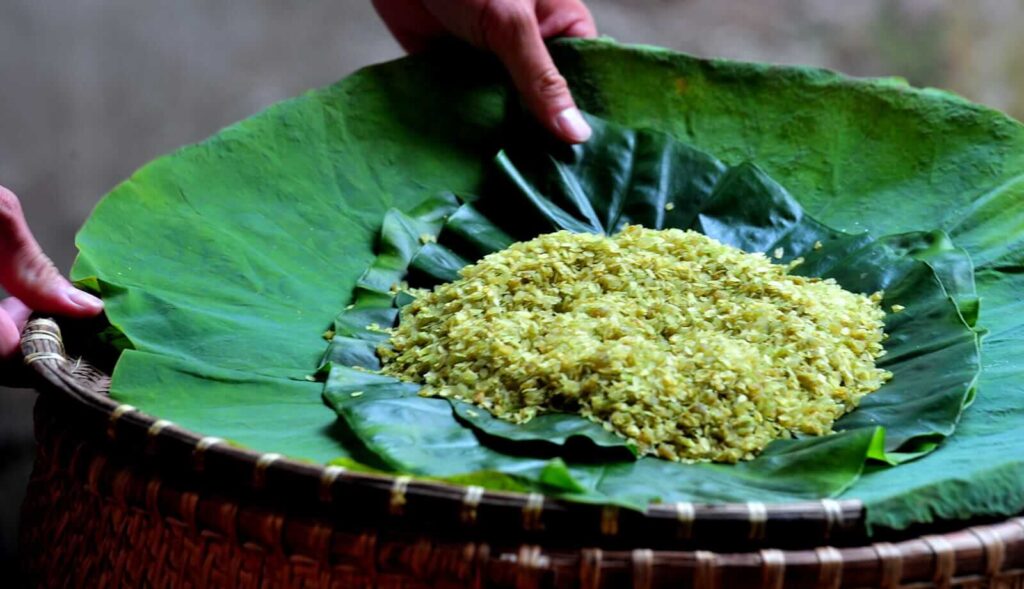
Vong Green Young Sticky Rice Making Village is a must-visit destination for foodies in Hanoi. Located in the outskirts of the city, this village is known for its specialty of green young sticky rice, which is a favorite dish among locals and tourists during the fall season.
The process of making this special type of sticky rice involves carefully selecting the young, unripe grains of rice, which are then roasted and pounded into a paste. The paste is mixed with pandan leaves to give it a green color and a fragrant aroma. The mixture is then steamed until it becomes sticky and fluffy.
The sticky rice is usually served with slices of ripe bananas, which provide a sweet and creamy contrast to the nutty and buttery flavor of the rice. The dish is typically eaten by hand, allowing you to fully savor the flavors and textures of the rice.
Visiting Vong village will allow you to witness the traditional process of making green young sticky rice and learn more about the cultural significance of this dish in Hanoi. You can observe the locals as they roast and pound the rice and even try your hand at making the dish yourself.
In addition to experiencing the food culture of Hanoi, you can also take in the picturesque scenery of the village, with its lush green fields and charming countryside. Overall, a visit to Vong Green Young Sticky Rice Making Village is a unique and memorable experience that should not be missed.
Location: Vong village, Dich Vong ward, Cau Giay district, Hanoi
8. Lang Van Rice Wine Village (Bac Giang)
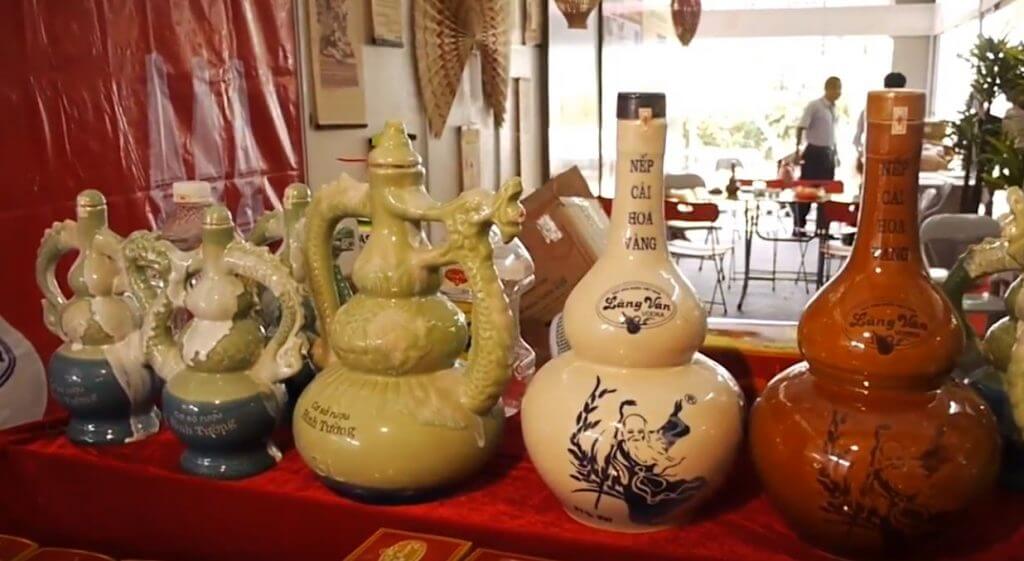
Lang Van Rice Wine Village, located in Van Ha commune, Bac Giang province, is a must-visit destination for wine lovers in Vietnam. Lang Van rice wine is well-known for its unique glassy and beautiful appearance, just like the sunlight in the summer. The secret behind the wine’s unique taste is the use of Golden flower glutinous rice, also known as Nep cai hoa vang, which is only grown in the fields of Van Xa village.
The wine-making process in Lang Van Rice Wine Village is carried out in a traditional way that has been passed down through generations. The rice is soaked in water and then cooked before being mixed with yeast and fermented in large jars for several months. After the fermentation process is complete, the wine is distilled and aged to perfection.
Drinking Lang Van rice wine is an enjoyable experience, as it adds a special essence to any meal. It is commonly served with traditional Vietnamese dishes such as grilled meat, pickled vegetables, and steamed sticky rice. The wine is also a popular gift to buy for family and friends, especially for those visiting Bac Giang province.
A visit to Lang Van Rice Wine Village will provide a unique insight into the local culture and traditions of Northern Vietnam. Visitors can witness the wine-making process firsthand, sample different varieties of rice wine, and purchase bottles to take home as souvenirs.
Location: Van village, Van Ha commune, Viet Yen district, Bac Giang province
6 Must-Visit Traditional Crafts Village in Central Vietnam
1. Bau Truc Pottery Making Village (Ninh Thuan)
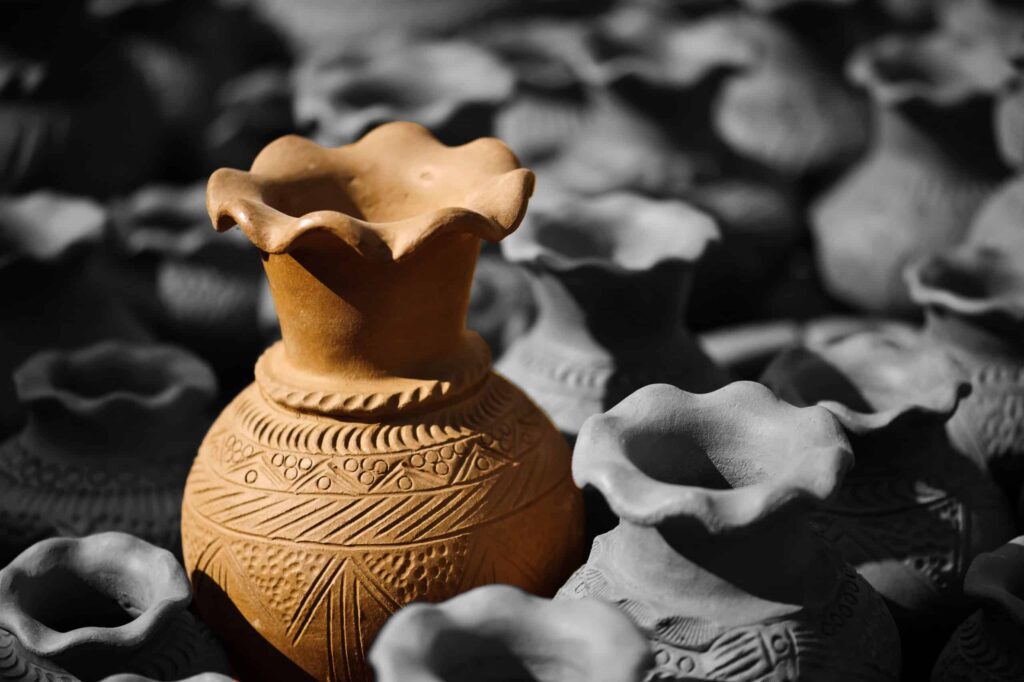
Bau Truc Pottery Making Village, located about 10 km south of Phan Rang town in Ninh Thuan province, is the oldest pottery village in Southeast Asia. The village has been in existence for over 200 years, and more than 400 families, of which about 85% are Cham people, make a living through the traditional pottery-making craft.
Unlike other traditional craft villages, Bau Truc looks very spacious and modern with concrete-paved streets, houses with red roofs, and stores. Visitors can see all the households busy with their work and instructing other visitors. Every product from the village is identical, featuring the daily life of Cham people. Decorated with available items like simple flowers, seashells, or hand-made paintings, the products still look impressive.
If you’re interested in learning about pottery making or just want to see the beautiful creations of the artisans, a visit to Bau Truc Pottery Making Village is a must.
Location: Phuoc Dan Town, Ninh Phuoc district, Ninh Thuan province
2. Yen Thai Poonah-paper Making Village (Quang Binh)
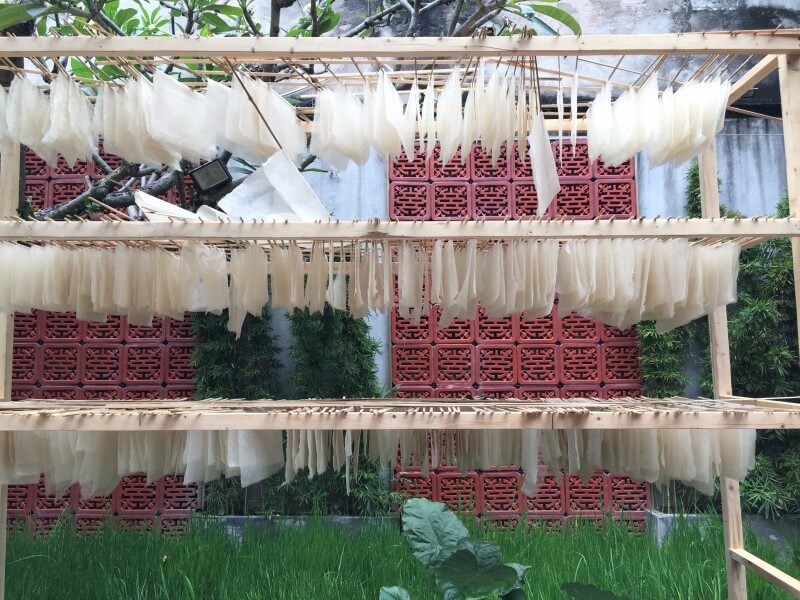
Yen Thai village, located in Quang Binh province, is famous for its long-standing tradition of poonah-paper making. The village has been producing different types of paper for more than six centuries, including edict papers used for writing royal edicts and order papers used for writing the King’s orders. The main material for making these papers comes from poonah trees, which are typical in the northern provinces of Vietnam.
To make poonah paper, Yen Thai villagers have to go through many precise and complicated processing steps. First, they select good quality materials from poonah trees, then soak them in water, and pound and flatten them into sheets. The poonah paper made in Yen Thai is known for its high quality and durability, making it widely used for writing Han scripts, printing folk paintings, and books.
Visitors to Yen Thai village can witness the paper-making process firsthand and even try their hand at making their own poonah paper. The village also has a small museum that showcases the history of poonah-paper making in Yen Thai and displays various types of paper made in the village.
Yen Thai village’s poonah-paper making tradition has been recognized as an intangible cultural heritage of Vietnam and has attracted many tourists and researchers interested in traditional paper-making methods.
Location: Yen Thai village, Quang Binh province
3. Conical Hat Making Villages (Hue)
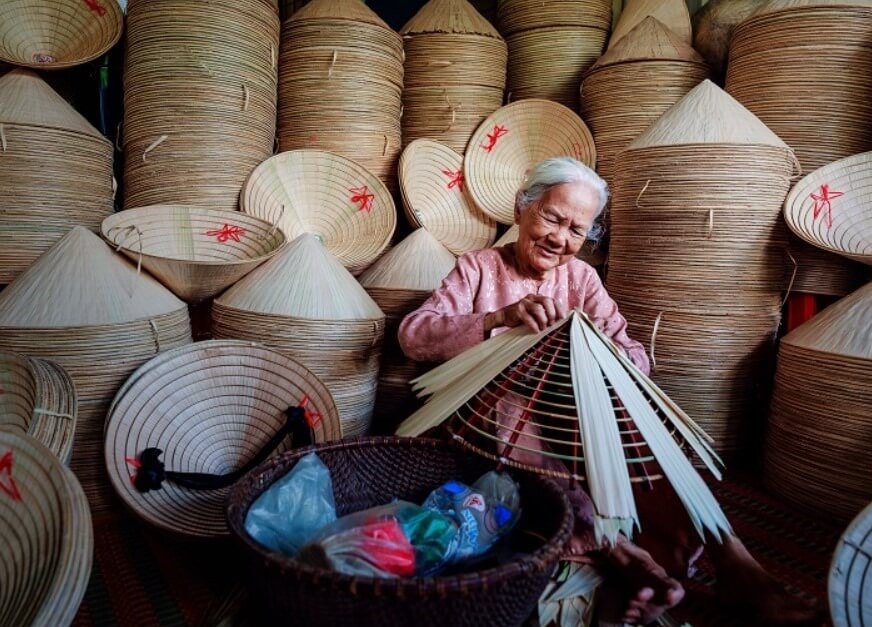
Conical hats, also known as non la, have been an iconic symbol of Vietnamese culture for centuries. These hats are especially associated with the image of graceful Vietnamese women wearing traditional áo dài dresses and conical hats. While there are several places in Vietnam that produce conical hats, Hue is the most renowned, with many conical hat-making villages such as Da Le, Phu Cam, Doc So, Trieu Tay, and Tay Ho.
Hue’s conical hats come in different styles and decorations, with many featuring famous Hue landscapes such as the Perfume River or Truong Tien Bridge. Some hats are even designed with Hue poetry, known as non bai tho, and feature unique characteristics.
The conical hat-making villages in Hue have been developing for hundreds of years, and the craft is still thriving today. Creating a conical hat requires a meticulous process that can involve up to 16 stages, with each step requiring the utmost care and skill from the craftsman’s hand. A visit to one of these villages during a Hue day trip is a must-see experience, as visitors can observe the artisans at work and even take home the most beautiful conical hats as souvenirs.
Discover Related Guides: 8 experiences worth trying when traveling to Hue city
4. Non Nuoc Stone Carving Village (Da Nang)
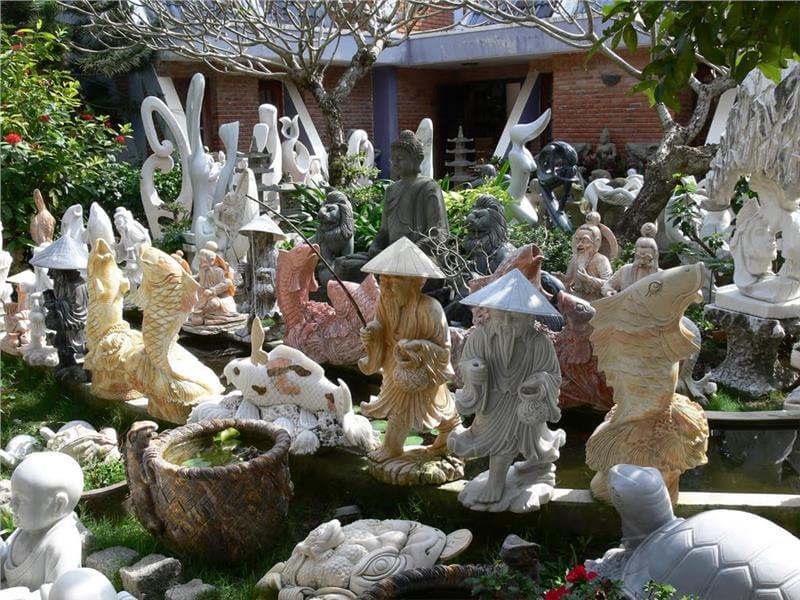
Non Nuoc Stone Carving Village is located at the foot of the Marble Mountains in Da Nang and is a famous traditional handicraft village in Vietnam. This village is known for its exquisite sculptures made from stone. Originally, the craft products were made to serve the daily life of locals, such as rice mortars, grain grinders, and tombstones. However, nowadays, the talented artisans have created more categories for different purposes, including worshipping, home decoration, and even jewelry.
The village has a long history that spans over 200 years. The carvers in Non Nuoc village take great pride in maintaining the relic site and protecting their traditional skills. Previously, the stones were taken directly from the Marble Mountains, but now the villagers are more aware of preserving their relic site, and the materials for their works are imported from other regions.
This village is a must-see attraction in Da Nang. Visitors can explore the craft village, admire the masterpieces, and watch the highly skilled carvers creating beautiful sculptures with love. There are thousands of carvers with more than 300 carving businesses in the village, making it one of the highest value exports of the city. So if you are in Da Nang, don’t miss the chance to visit Non Nuoc Stone Carving Village, an exceptional craft village in central Vietnam.
Location: Non Nuoc stone carving village, Hoa Hai ward, Ngu Hanh Son district, Da Nang city
Explore More: Top 5 best nature attractions in Danang
5. Kim Bong Carpentry Village (Hoi An, Quang Nam)
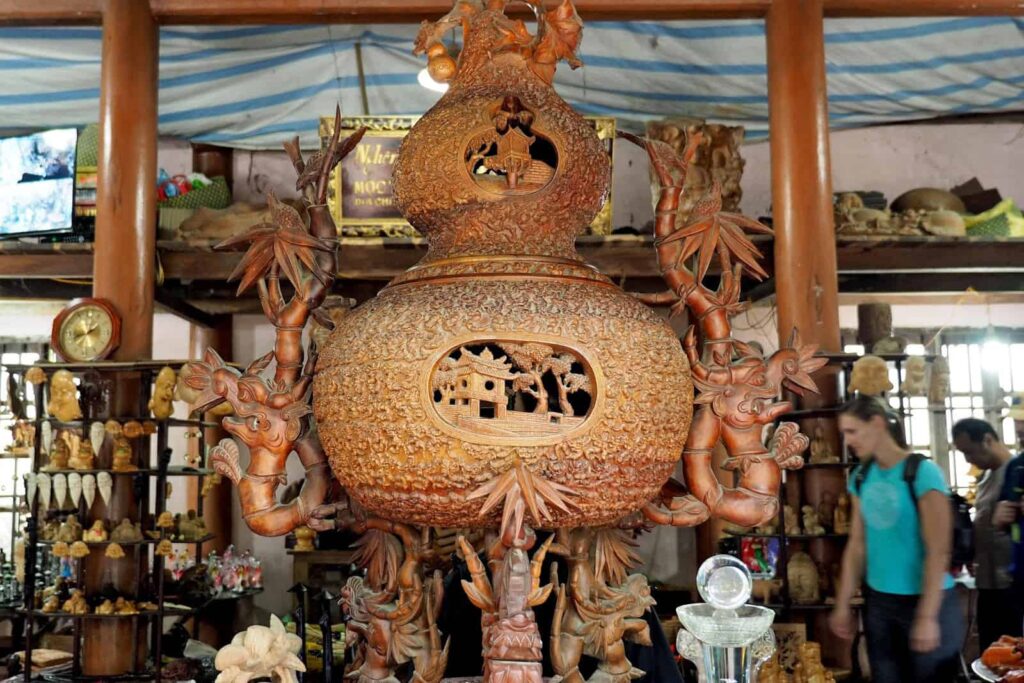
Kim Bong Carpentry Village is a well-known traditional craft village located in Hoi An, Quang Nam province. The village is famous for its beautiful wooden products and impressive carpentry works that showcase unique cultural values. The village has been operating for centuries and is a popular tourist attraction for both domestic and international visitors.
The carpentry style of Kim Bong is a fusion of different influences, including Chinese, Japanese, and Cham Kingdom, with the skilled hands of Vietnamese craftsmen. Many of the carpenters in the village are descendants of famous artisans who served the royal family during the Nguyen Dynasty. They inherited the talent and skills of their ancestors, and their works have been widely recognized and appreciated by art lovers around the world.
Visitors can freely explore the village and watch the skilled carpenters working on their masterpieces. There is no entrance fee, and visitors can also visit the souvenir shops of local people to purchase small wooden items as souvenirs or gifts for friends and family.
Location: Kim Bong carpentry village, Cam Kim commune, Hoi An, Quang Nam
Related Guides: 3 hundred-year-old craft villages in Hoi An you should know
6. Phuoc Kieu Bronze-casting Village (Quang Nam)
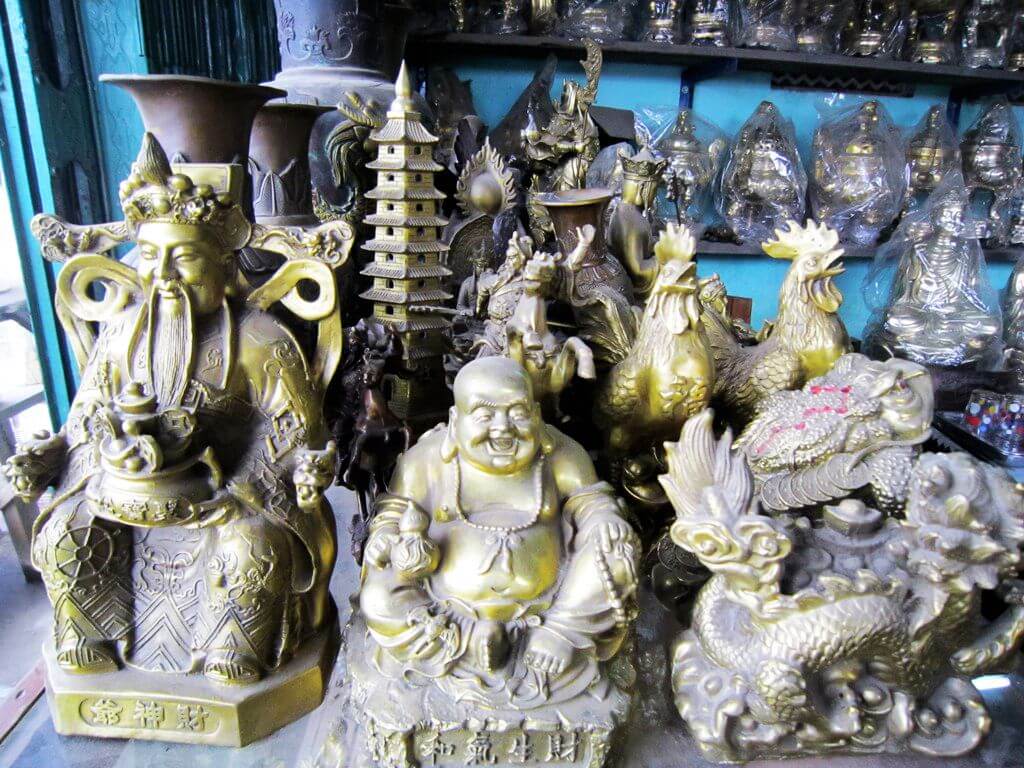
Phuoc Kieu village, located in Quang Nam province, is a renowned traditional bronze-casting village in Vietnam. Established in the 16th century, the skilled hands of the local villagers have been producing various bronze products such as ancient vases, burners, and lamp holders. Additionally, the village is well-known for crafting numerous instruments, especially the gong, which is widely used in ethnic communities throughout Vietnam.
During your visit to the village, you can witness the entire process of making bronze products, from the initial stages to the final products. What sets Phuoc Kieu village apart from other villages is the exciting addition of a bronze musical performance by the artists during the observation of the process. It is undoubtedly an enriching experience to visit the village and learn about one of Vietnam’s oldest traditional crafts.
Location: Dien Phuong commune, Dien Ban district, Quang Nam province
3 Must-Visit Traditional Crafts Village in Southern Vietnam
1. Tan Chau Black Silk Village (An Giang)
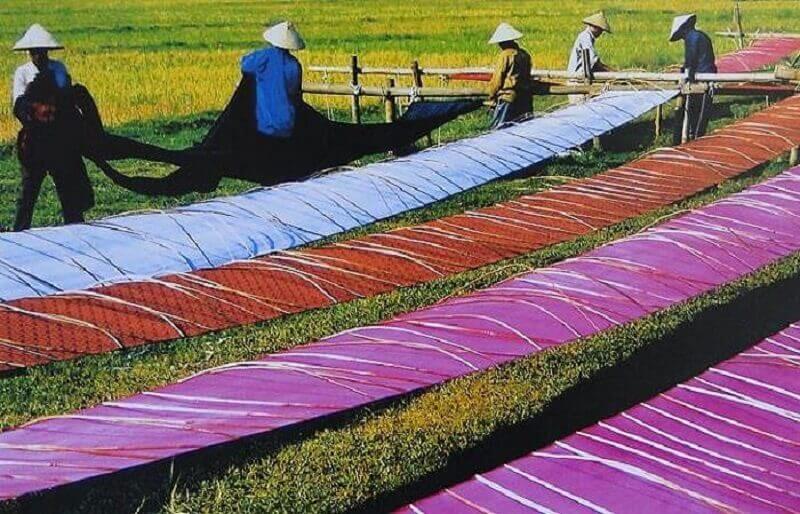
Tan Chau Black Silk Village, located in the northwest of An Giang province, is famous for its exquisite silk products made by skillful weavers. In the 20th century, clothes made of Tan Chau silk were highly coveted by Vietnamese women. Visiting Tan Chau, you can witness the lush green of mulberry trees stretching along the riverbanks and fields, from one village to another.
During your visit, the friendly villagers will show you the intricate process of silk-making, from raising silkworms to spinning and weaving the silk. In some steps, such as turning the silk, you can even try it yourself with the guidance of the locals. Tan Chau silk products are known for their smooth texture, durability, and unique patterns. Don’t miss the chance to visit this charming village and discover the secrets behind this renowned traditional craft.
Location: Tan Chau town, An Giang province
2. Ben Tre Coconut Candy Village (Ben Tre)
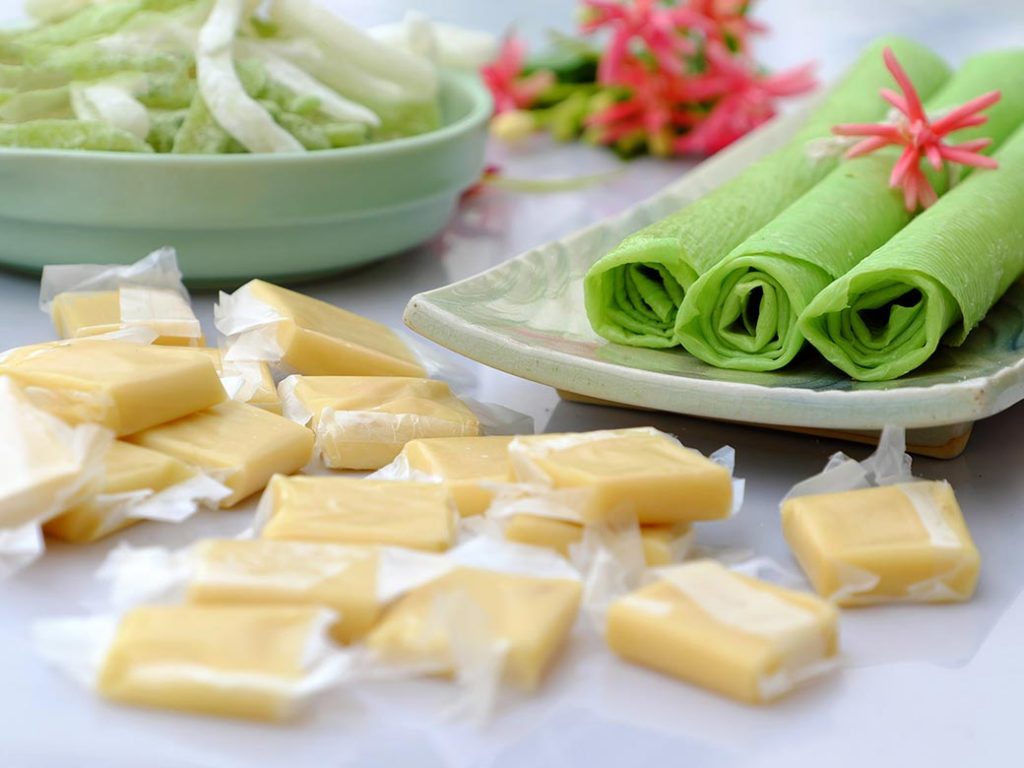
Ben Tre Coconut Candy Village located in Ben Tre province, Vietnam has become a popular tourist destination due to its unique and delicious coconut candy. The village is known for being the first to create and develop the art of making coconut candy, which has become a signature product of the region.
As you approach the village, you’ll be greeted by the sweet aroma of coconuts. The candy is made using various materials such as sugar, malt, and coconut milk, creating a distinct and delightful flavor. You’ll be able to witness the process of making the candy and even try it out for yourself.
Visiting the Ben Tre Coconut Candy Village is a great way to experience the local culture and see traditional manual labor in action.
Location: Mo Cay town, Mo Cay district, Ben Tre province
3. Ba Dai Ship-crafting Village (Dong Thap)
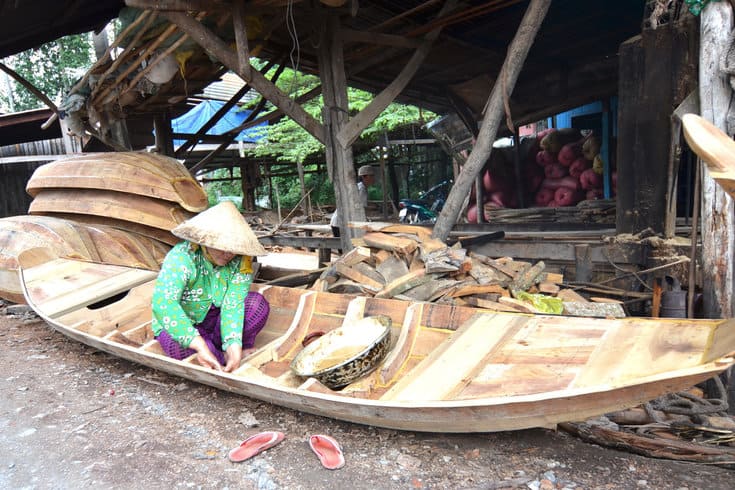
Ba Dai Ship-crafting Village in Dong Thap province is a unique cultural destination in Vietnam. With its location in the heart of the Mekong Delta, this village is famous for producing high-quality boats and junk that are essential for transportation in the region.
The craft of ship-making has been passed down for generations in Ba Dai village, and it has become a part of the local heritage. The boats made here are known for their superior quality and aesthetic appeal, making them a popular choice for locals and visitors alike.
When you visit Ba Dai village, you can witness the entire process of boat making, from selecting the wood to the final touches of decoration. You can even try your hand at making a small souvenir boat for yourself or your loved ones. The village is also home to several small shops where you can buy souvenirs, handicrafts, and other locally made products.
A visit to Ba Dai Ship-crafting Village is a great way to learn about traditional crafts and experience the unique culture of the Mekong Delta.
Location: Long Hau commune, Lai Vung district, Dong Thap province
We hope that the list of 15+ famous traditional craft villages in Vietnam provided above will assist you in selecting a favorite destination to visit. We are confident that these villages will add a touch of sparkle and create lasting memories during your trip to Vietnam.






